Many businesses face the challenge of standing out in a crowded ecommerce market. Shopify’s standard themes and basic apps can limit your brand’s uniqueness, performance, or specific n9 Top Custom Storefront Apps for Shopify in 2024 – Shopify App Storeeeds. That’s where custom storefront apps come in.
In this article, we’ll explore 9 powerful Shopify custom storefront apps that help you build personalized, high-performance stores. Whether you’re running a growing D2C brand, managing multiple clients as a Shopify agency, or an ecommerce store owner looking to break free from the restrictions of Shopify’s default options, these apps offer flexibility, scalability, and tools to meet your needs.
From building headless storefronts that improve site speed and offer more design freedom, to using drag-and-drop page builders for non-coders, we’ll dive deep into the best tools available. Ready to supercharge your Shopify store with custom storefronts? Let’s get started.
The top categories for Shopify stores include apparel (520,321 stores), home and garden (221,381), and beauty and fitness (186,706).( Source )
What is a Custom Shopify Storefront?
A custom Shopify storefront is a fully customized solution where you have complete control over your store’s design, layout, and functionality. Unlike traditional Shopify themes, a custom storefront allows you to decouple the front end (what your customers see) from the back end (how your store operates). This is often referred to as headless commerce.
In simpler terms, you can build the entire user interface (UI) using any technology you prefer, such as React, Vue.js, or Next.js, while Shopify still powers all the backend operations—inventory management, payment processing, and checkout. This gives you freedom to design a unique and responsive store that perfectly matches your brand’s vision
How Custom Storefronts Work
Custom storefronts rely on Shopify’s Storefront API, which allows developers to fetch data like products, collections, and customer information. You build your front end from scratch while still using Shopify’s powerful commerce engine in the backgroundThis opens up endless possibilities for customization and flexibility, allowing you to:
- Create fast-loading websites with Server-Side Rendering (SSR) and Static Site Generation (SSG).
- Integrate with third-party tools like CMS, CRM, ERP, or PIM systems
- Build a scalable store that can handle high traffic and support multiple devices or channels.
Why Do You Need a Custom Storefront?
A custom storefront is ideal for businesses that:
- Have complex content needs or want a unique brand experience that’s not achievable with standard Shopify themes.
- Need a flexible, scalable store to support high traffic or omnichannel strategies.
- Want to improve site speed and performance, which can directly impact sales.
Why Ecommerce Businesses Need Custom Storefronts
Most ecommerce businesses reach a point where the default Shopify themes just don’t cut it anymore. As your brand grows, you’ll likely need a more unique, scalable, and high-performance solution. This is where custom storefronts shine. Let’s break down some key reasons why custom storefronts can transform your business:
1. Brand Uniqueness and Flexibility
A custom storefront lets you create a unique shopping experience. You’re not tied to the limitations of Shopify’s default themes or templates. Whether you’re a D2C brand that thrives on storytelling or a niche ecommerce business looking to stand out, a custom storefront lets you implement your own visual identity, including animations, interactive features, and design elements that resonate with your target audience.
For example, a brand like Thrive Causemetics uses a clean, product-focused layout that puts their cause at the forefront of the customer experience.With a custom storefront, you can implement specific features like gift-with-purchase, personalized upsells, or interactive elements to keep customers engaged.
2. Improved Performance and Speed
Speed is critical for ecommerce. Custom storefronts built with headless frameworks like Hydrogen allow your store to perform better, especially during high traffic. Using technologies like Server-Side Rendering (SSR) and Static Site Generation (SSG) ensures that pages load faster and boost your Core Web Vitals, which directly impacts SEO rankings and conversion ratesFaster-loading pages mean fewer bounce rates and more sales.
3. Omnichannel Experiences
Custom storefronts offer the flexibility to provide a seamless experience across multiple channels. You can unify your web, mobile, social, and in-store experiences, ensuring consistency across all touchpoints. For example, brands can integrate Shopify with other tools and build custom shopping experiences in mobile apps, social media, or even AR/VR platformsThis omnichannel approach helps you reach customers where they are, be it on their phones, desktops, or even smart devices like fridges in the case of IoT-based commerce
4. Scalability for Growth
As your business grows, so do your needs. Custom storefronts allow for horizontal scaling, ensuring that your store can handle peak traffic without slowing down. For example, brands like Gymshark have leveraged custom storefronts to scale up during high-traffic sales eventsWith a modular architecture, you can easily add or replace features without disrupting the whole site. This ensures your store grows with your business without needing a complete overhaul.
5. Advanced Integrations
Custom storefronts give you the freedom to integrate with third-party tools such as CMS (Content Management Systems), CRM (Customer Relationship Management), ERP (Enterprise Resource Planning), and PIM (Product Information Management) systemsThis means you can centralize your store’s data while offering personalized customer experiences, better inventory management, or seamless content delivery across all platforms.
Read More:Top 6 Best Shopify Mobile App Builders for Your Store
Top 9 Shopify Custom Storefront Apps
These apps provide the tools you need to break free from the limitations of standard Shopify themes. Whether you want to build a completely custom store or simply tweak your existing one, these apps can help. Let’s dive into the features, pricing, pros, cons, and who each app is best suited for:
1. Hydrogen
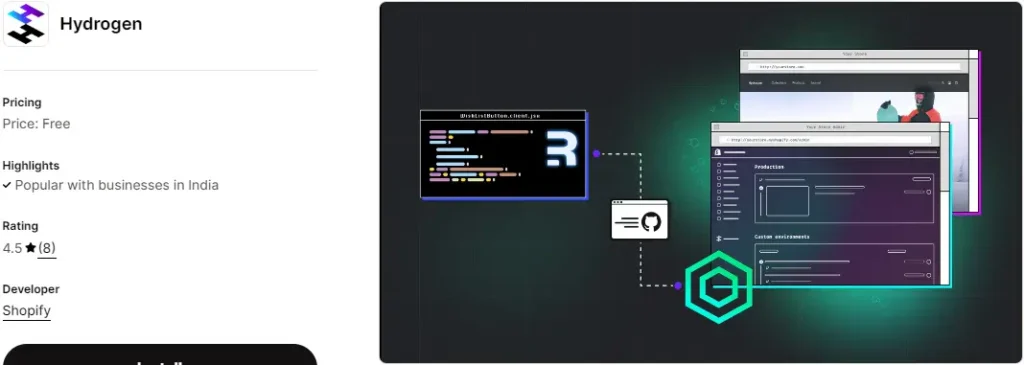
- Key Features:
- Shopify’s in-house framework for building headless storefronts.
- Pre-built components for rapid development.
- Server-side rendering (SSR) and Static Site Generation (SSG) for faster load times.
- Deep Shopify integration for seamless backend management.
- Pricing: Free.
- Pros:
- Complete control over your storefront’s design and performance.
- Optimized for speed, which improves SEO and conversion rates.
- Developer-friendly with built-in templates.
- Cons:
- Requires technical knowledge to set up and maintain.
- Best suited for larger brands with development resources.
- Rating: 4.7/5
- Best For: Large ecommerce businesses or tech-savvy brands with unique storefront needs.
2. Sanity Connect

- Key Features:
- Integrates headless CMS for managing content outside of Shopify.
- Supports omnichannel content management for consistency across platforms.
- API-based, allowing for full customization of the front-end experience.
- Pricing: Free, with tiered pricing based on usage.
- Pros:
- Perfect for content-heavy stores or brands that rely on storytelling.
- Real-time collaboration for editing and managing content.
- Cons:
- Higher learning curve; requires development work.
- The cost can increase significantly as usage scales.
- Rating: 3.5/5
- Best For: Brands with complex content needs or those managing content across multiple channels.
Read More:12 Best Shopify Retail Apps: Top Products Apps on the Shopify App Store
3. GemPages

- Key Features:
- Drag-and-drop page builder with customizable templates for landing pages, homepages, and product pages.
- No coding required, making it easy to use for beginners.
- SEO-friendly and optimized for fast page load speeds.
- Pricing: Starts at $15/month.
- Pros:
- User-friendly interface, great for non-technical users.
- Offers full customization of pages without needing to code.
- Cons:
- Limited advanced customization options for more complex needs.
- Basic plan may not offer enough flexibility for larger businesses.
- Rating: 4.8/5
- Best For: Ecommerce store owners or agencies looking to quickly build or customize pages without developer assistance.
4. Shogun
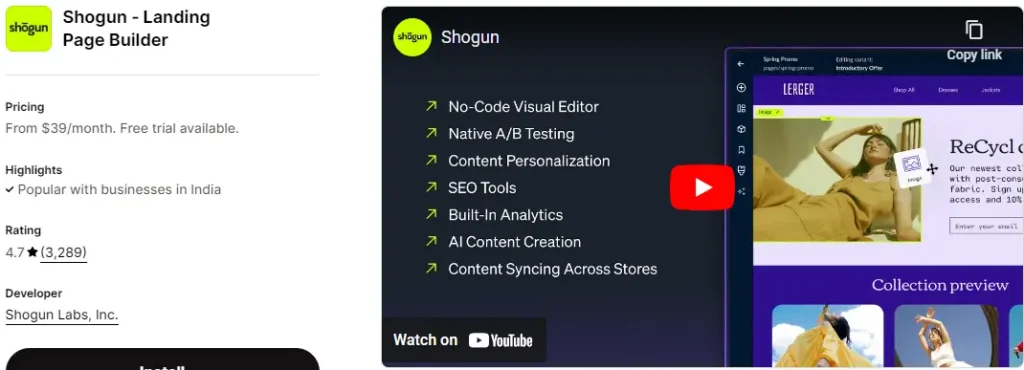
- Key Features:
- Advanced landing and product page builder that integrates seamlessly with Shopify.
- Allows full customization of your Shopify store’s frontend using a drag-and-drop interface.
- Optimized for speed to ensure fast loading times.
- Pricing: Starts at $39/month.
- Pros:
- Ideal for building high-converting landing pages without needing coding knowledge.
- Great integration with Shopify, offering fast and responsive pages.
- Cons:
- Relatively high price compared to other page builders.
- Limited functionality in the basic plan.
- Rating: 4.7/5
- Best For: Shopify merchants who need high-converting landing pages with ease of use.
Read More:7 Best Shopify Sales Channels Apps – Shopify App Store
5. Spocket
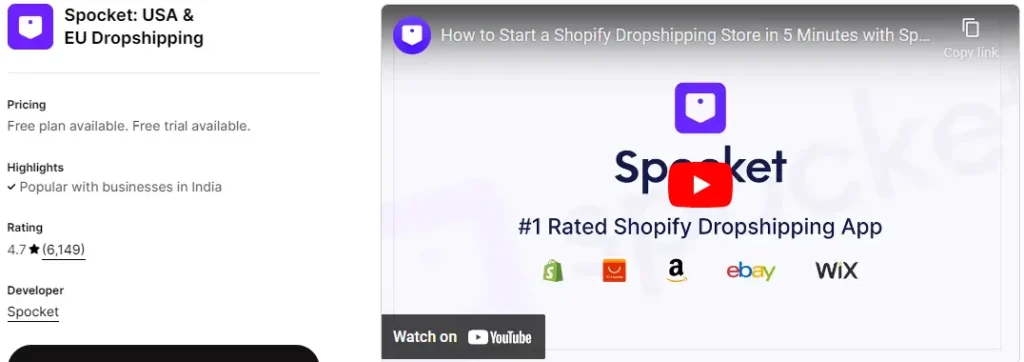
- Key Features:
- An app designed for dropshipping businesses, helping source products from suppliers globally.
- Real-time inventory syncing and automatic order fulfillment.
- Offers fast shipping options for the US and Europe.
- Pricing: Free plan available; premium starts at $24.99/month.
- Pros:
- Excellent for dropshipping businesses looking for reliable suppliers.
- Large catalog of products, especially for fast-shipping regions.
- Cons:
- Somewhat limited selection of products outside major regions.
- Premium plans needed for advanced features like branded invoicing.
- Rating: 4.7/5
- Best For: Dropshipping businesses focusing on fast fulfillment and reliable suppliers.
6. Beae Landing Page Builder
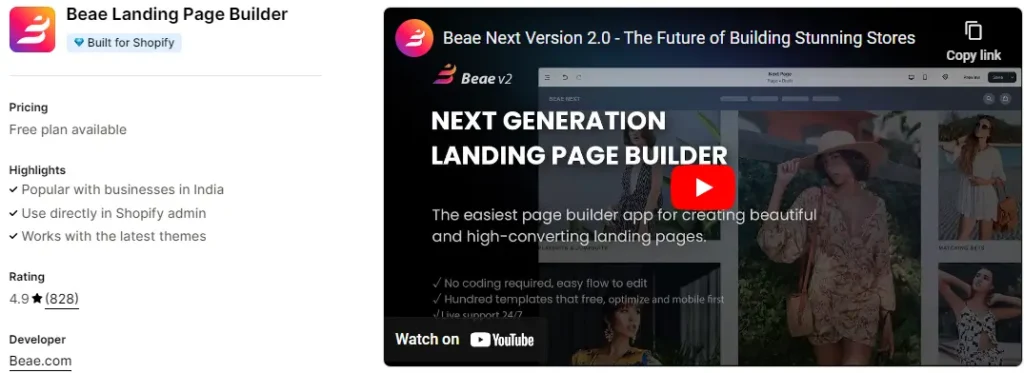
- Key Features:
- Drag-and-drop builder for creating homepages, product pages, and landing pages.
- Multiple pre-designed templates for easy setup.
- Custom sections for branding and marketing campaigns.
- Pricing: Free plan available, premium starts at $19/month.
- Pros:
- Affordable and simple to use for non-technical users.
- Offers great flexibility for basic page customization.
- Cons:
- Limited integrations with advanced third-party apps.
- Fewer features compared to more premium page builders.
- Rating: 4.9/5
- Best For: Smaller Shopify stores or merchants looking for a simple and affordable page builder.
Read More:10 Top Shopify Apps for Order Fulfillment
7. EComposer

- Key Features:
- All-in-one page builder for landing pages, collection pages, and more.
- Real-time preview during editing for quicker adjustments.
- Built-in SEO features for better rankings.
- Pricing: Free plan available; paid plans start at $19.99/month.
- Pros:
- Simple drag-and-drop interface, ideal for quick edits.
- SEO-friendly out of the box.
- Great for smaller stores or businesses new to page building.
- Cons:
- Limited advanced features for larger stores.
- May not offer enough customization for complex stores.
- Rating: 5.0/5
- Best For: Small to mid-sized Shopify stores that need a fast, affordable solution for creating custom pages.
8. Octane AI

- Key Features:
- Builds interactive quizzes to personalize product recommendations for customers.
- Collects valuable data for retargeting and personalized marketing.
- Integrates seamlessly with Shopify to boost sales.
- Pricing: Free plan available; premium starts at $29/month.
- Pros:
- Increases engagement with personalized product quizzes.
- Boosts conversion rates through tailored recommendations.
- Cons:
- Limited customization options for quizzes.
- Costs can rise for higher usage or advanced features.
- Rating: 4.9/5
- Best For: D2C brands that want to offer personalized shopping experiences and improve customer engagement.
Read More:8 Best Shopify Packaging Apps
9. Headless
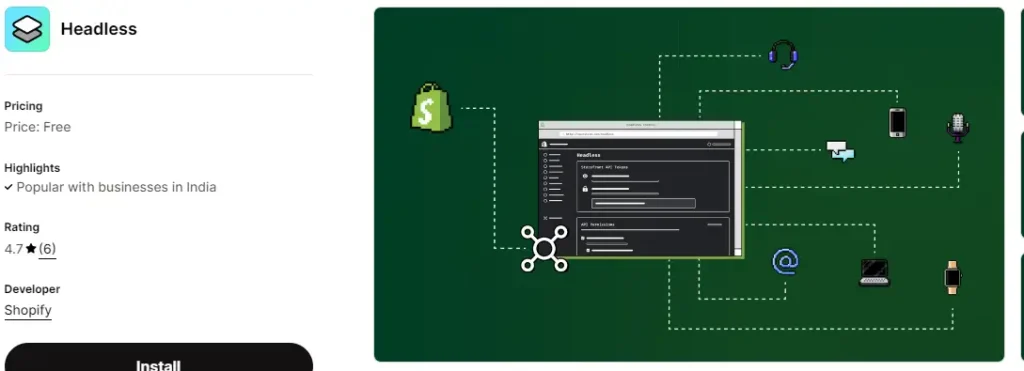
- Key Features:
- Fully headless API-first solution for building custom storefronts.
- Integrates with any frontend technology for full design freedom.
- Ideal for omnichannel experiences across multiple touchpoints.
- Pricing: Free.
- Pros:
- Complete control over the frontend, with unlimited customization possibilities.
- Great for brands that need flexibility across multiple channels.
- Cons:
- Requires technical expertise to set up and maintain.
- Higher costs for development and ongoing management.
- Rating: 4.7/5
- Best For: Large-scale ecommerce stores with advanced technical resources looking to scale across different platforms.
When to Consider a Custom Storefront
Not every business needs a custom Shopify storefront right away. However, as your ecommerce brand grows or your technical needs become more complex, there are clear signs that you might benefit from upgrading to a custom storefront solution. Here are some common scenarios where investing in a custom storefront is worth considering:
1. When You Need a Unique Brand Experience
If your brand needs a completely unique look and feel that can’t be achieved through Shopify’s standard themes, a custom storefront offers full control over design and user experience. This can include:
- Complex animations or interactive elements.
- Full customization of layouts, product pages, and navigation.
- Tailored mobile and desktop experiences.
Many D2C brands, such as Gymshark, use custom storefronts to reflect their brand’s specific identity and engage customers on a deeper levelA custom solution ensures you’re not confined by Shopify’s existing themes and templates, giving you freedom to design the store exactly how you want it.
2. When Performance and Speed Are Critical
A fast, responsive site is key to converting customers. Custom storefronts built using headless frameworks like Hydrogen allow you to implement advanced technologies like Server-Side Rendering (SSR) and Static Site Generation (SSG)This significantly improves your store’s performance, even during peak traffic periods.For businesses running major campaigns or dealing with high traffic volumes (especially during sales seasons like Black Friday), a custom storefront ensures that pages load quickly and perform efficiently. Improved Core Web Vitals can directly lead to better SEO rankings and higher conversion rates.
3. When You’re Going Omnichannel
If you want to provide a seamless shopping experience across multiple platforms—like mobile, social media, or even IoT devices—a custom storefront allows you to integrate various touchpoints into one consistent experience. This flexibility helps you unify customer journeys, ensuring they experience the same branding and usability whether they’re shopping on their phones, a desktop, or through your mobile appFor example, ecommerce stores that use Progressive Web Apps (PWAs) can offer an app-like experience directly on the browser, improving mobile engagement without the need for a full app
4. When You Require Advanced Integrations
A custom storefront gives you the flexibility to integrate with advanced third-party tools that may not be easily compatible with Shopify’s default setup. For example, businesses that need to incorporate:
- CMS (Content Management System) for complex content needs.
- CRM (Customer Relationship Management) to better manage customer interactions.
- ERP (Enterprise Resource Planning) for inventory management.
- PIM (Product Information Management) systems for managing product data across channels
If you’re using multiple platforms to run your business, custom storefronts allow you to seamlessly integrate these tools with your Shopify store.
5. When Scalability Becomes a Priority
As your store grows, you need a platform that can scale with your business. A custom storefront allows you to:
- Horizontally scale to handle high traffic.
- Modularize your architecture, so you can easily replace or upgrade components without disrupting the whole system.
This makes custom storefronts ideal for businesses with ambitious growth plans, as they provide the flexibility and scalability needed to support larger, more complex operation.
FAQs
What is a Shopify custom storefront?
A custom Shopify storefront is a fully customized front end built independently from Shopify’s default themes. You can use your preferred technology (e.g., React, Vue.js) to create a unique user experience, while Shopify powers the backend, including inventory, checkout, and payment processing.
When should I switch to a custom storefront?
Consider switching to a custom storefront when your business requires advanced customization, better performance, or needs to integrate with third-party tools like CMS, CRM, or ERP systems. If your current theme is limiting your brand’s potential, a custom storefront can provide more flexibility.
Do custom storefronts improve site speed?
Yes, custom storefronts can significantly improve site speed when built using technologies like Server-Side Rendering (SSR) and Static Site Generation (SSG). These frameworks optimize performance, leading to faster load times, improved SEO rankings, and better overall user experiences.
How much does it cost to build a custom storefront on Shopify?
The cost varies depending on the complexity of your storefront. While using apps like GemPages or Shogun starts at around $15 to $39 per month, a fully custom solution built with frameworks like Hydrogen can require significant investment in development resources and ongoing maintenance.
Can I build a custom storefront without coding knowledge?
Yes, tools like Shogun and GemPages allow you to create custom pages using drag-and-drop builders without needing coding skills. However, for more advanced customizations (like a fully headless solution), you will need developer assistance.
Conclusion
Custom Shopify storefronts offer unmatched flexibility, allowing you to break free from the limitations of default Shopify themes. Whether you need a unique design, faster load times, or scalable infrastructure, the tools are out there to help you achieve your vision.
Using a combination of headless commerce frameworks like Hydrogen, drag-and-drop page builders like GemPages and Shogun, or integration-friendly tools like Sanity Connect, you can tailor your Shopify store to meet your business needs. From small ecommerce stores to large, complex businesses, custom storefronts provide the solution to growth challenges and brand differentiation.
Ultimately, building a custom storefront is an investment. It requires development resources and ongoing maintenance, but the benefits—faster site speeds, a unique customer experience, and the ability to scale—far outweigh the initial effort.
If your business is hitting the limits of Shopify’s standard themes and apps, now might be the time to explore custom storefronts. The apps we’ve covered in this guide provide a variety of solutions to match your business’s stage, budget, and needs.


